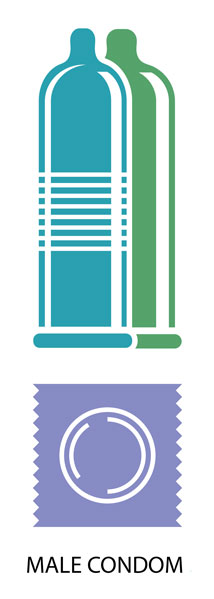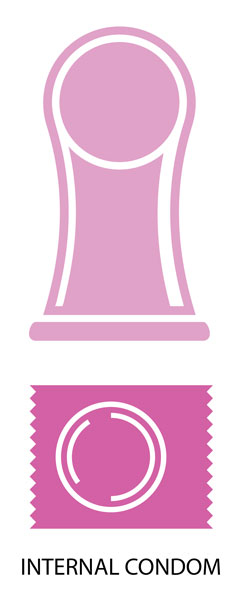for Veterans and the Public
Tips for using condoms and dental dams
If you need condoms, you can ask your VA provider for a prescription for condoms at your next visit. If you are not used to using condoms: practice, practice, practice.
Male condom dos and don'ts:

- For a visual guide to using male condoms, check out this CDC page

- Shop around: Use lubricated latex condoms. Always use latex, because lambskin condoms don't block HIV and STDs, and polyurethane condoms break more often than latex (if you are allergic to latex, polyurethane condoms are an option). There is a lot of variety--one will work for you!
- Keep it fresh: Store condoms loosely in a cool, dry place (not your wallet). Check the expiration date. Throw away condoms that have expired, were exposed to very hot temperatures, or were washed in the washer. If you think the condom might not be good, get a new one.
- Take it easy: Open the package carefully, so that you don't rip the condom and make sure that the condom package has not been punctured (there should be a pocket of air). Check the condom for damaged packaging and signs of aging such as brittleness, stickiness, and discoloration.
- Keep it hard: Put on the condom after the penis is erect and before it touches any part of a partner's body. If a penis is uncircumcised (uncut), the foreskin must be pulled back before putting on the condom.
- Heads up: Make sure the condom is right-side out. Before you put it on the penis, unroll the condom about half an inch to see which direction it is unrolling. Then put it on the head of the penis and hold the tip of the condom between your fingers as you roll it all the way down the shaft of the penis from head to base. This keeps out air bubbles that can cause the condom to break. It also leaves a space for semen to collect after ejaculation.
- Slippery when wet: If you use a lubricant (lube), it should be a water-soluble lubricant (for example, ID Glide, K-Y Jelly, Slippery Stuff, Foreplay, Wet, Astroglide) in order to prevent breakdown of the condom. Put lubricant on after you put on the condom, not before — it could slip off. Add more lube often. Dry condoms break more easily. Products such as petroleum jelly, massage oils, butter, Crisco, Vaseline, and hand creams are not considered water-soluble lubricants and should not be used.
- Come and go: Withdraw the penis immediately after ejaculation, while the penis is still erect; grasp the rim of the condom between your fingers and slowly withdraw the penis (with the condom still on) so that no semen is spilled.
- Clean up: Throw out the used condom right away. Tie it off to prevent spillage or wrap it in bathroom tissue and put it in the garbage. Condoms can clog toilets. Use a condom only once. Never use the same condom for vaginal and anal intercourse. Never use a condom that has been used by someone else.
Do you have to use a condom for oral sex?
It is possible for oral sex to transmit HIV, whether the infected partner is performing or receiving oral sex. But the risk is very low compared with unprotected vaginal or anal sex, however other sexually transmitted infections can be transmitted through oral sex.
If you choose to perform oral sex, you may:
- use a latex condom on the penis; or
- use a latex barrier (such as a natural rubber latex sheet, a dental dam, or a cut-open condom that makes a square) between your mouth and the vagina. A latex barrier such as a dental dam reduces the risk of blood or vaginal fluids entering your mouth. Plastic food wrap also can be used as a barrier. For a visual guide to using dental dams for oral sex, check out this CDC page
 .
. - if either you or your partner are allergic to latex, plastic (polyurethane) condoms can be used.
If you perform oral sex and this sex includes oral contact with your partner's anus (anilingus or rimming),
- use a latex barrier (such as a natural rubber latex sheet, a dental dam, or a cut-open condom that makes a square) between your mouth and the anus. Plastic food wrap also can be used as a barrier.
If you share sex toys, such as dildos or vibrators, with your partner,
- each partner should use a new condom on the sex toy; and be sure to clean sex toys between each use.
Internal condom (also called female condom)

This type of condom was originally designed to be inserted into the vagina before sex. It also can be used in the anus, by either men or women, though its effectiveness in preventing HIV transmission via anal sex has not been studied.
The internal condom is a large condom fitted with larger and smaller flexible rings at each end. The rings help keep it inside the vagina during sex; for anal sex, the inner ring usually is removed before it is inserted. It is made of nitrile, so any lubricant can be used without damaging it. It may seem a little awkward at first, but can be a useful alternative to the traditional "male" condom. Female condoms generally cost more than male condoms. For a visual guide on using an internal condom, check out this CDC page![]() . Remember to:
. Remember to:
- Store the condom in a cool dry place, not in direct heat or sunlight.
- Throw away any condoms that have expired--the date is printed on the wrappers.
- Check the package for damage and check the condom for signs of aging such as brittleness, stickiness, and discoloration. The internal condom is lubricated, so it will be somewhat wet.
- Before inserting the condom, you can squeeze lubricant into the condom pouch and rub the sides together to spread it around.
- Put the condom in before sex play because pre-ejaculatory fluid, which comes from the penis, may contain HIV. The condom can be inserted up to 8 hours before sex.
- The internal condom has a firm but flexible ring at each end of it. To insert the condom in the vagina, squeeze the ring at the closed end between the fingers (like a diaphragm), and push it up into the back of the vagina. The open ring must stay outside the vagina at all times, and it will partly cover the lip area. For use in the anus, most people remove the internal ring before insertion.
- Do not use a male condom with the internal condom.
- Do not use an internal condom with a diaphragm.
- If the penis is inserted outside the condom pouch or if the outer ring (open ring) slips into the vagina, stop and take the condom out. Use a new condom before you start sex again.
- Don't tear the condom with fingernails or jewelry.
- Use a condom only once and properly dispose of it in the trash (not the toilet).




















